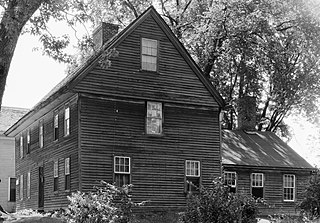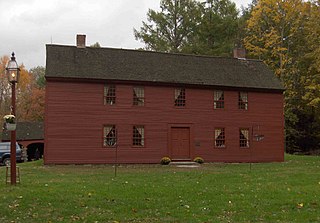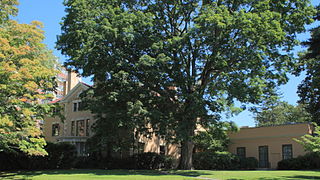
The Emily Dickinson Museum is a historic house museum consisting of two houses: the Dickinson Homestead and the Evergreens. The Dickinson Homestead was the birthplace and home from 1855 to 1886 of 19th-century American poet Emily Dickinson (1830–1886), whose poems were discovered in her bedroom there after her death. The house next door, called the Evergreens, was built by the poet's father, Edward Dickinson, in 1856 as a wedding present for her brother Austin. Located in Amherst, Massachusetts, the houses are preserved as a single museum and are open to the public on guided tours.

The Franklin Pierce Homestead is a historic house museum and state park located in Hillsborough, New Hampshire. It was the childhood home of the fourteenth president of the United States, Franklin Pierce.

The Joseph F. Glidden House is located in the United States in the DeKalb County, Illinois city of DeKalb. It was the home to the famed inventor of barbed wire Joseph Glidden. The barn, still located on the property near several commercial buildings, is said to be where Glidden perfected his improved version of barbed wire which would eventually transform him into a successful entrepreneur. The Glidden House was added to the National Register of Historic Places in 1973. The home was designed by another barbed wire patent holder in DeKalb, Jacob Haish.

The Buttolph–Williams House is a historic house museum at 249 Broad Street in Wethersfield, Connecticut. Built in 1711, it is one of the oldest surviving houses in the town. It is owned by Connecticut Landmarks, a historic preservation organization, and is open for regular tours between May and October. it was designated a National Historic Landmark in 1968 for its significance as an extremely well-preserved example of early colonial architecture.

The Oliver Ellsworth Homestead, also known as Elmwood, is a historic house museum at 788 Palisado Avenue in Windsor, Connecticut. Built in 1781, it was the home of the American lawyer and politician Oliver Ellsworth until his death in 1807, and was designated a National Historic Landmark because of this association. Ellsworth (1745–1807) helped draft the United States Constitution, served as the third Chief Justice of the United States, and was a United States Senator from Connecticut. The house is owned and maintained and operated as a museum by the Connecticut Daughters of the American Revolution, and is open for tours upon request.

The Huntington Homestead, also known as the Samuel Huntington Birthplace, is a historic house museum and National Historic Landmark at 36 Huntington Road in Scotland, Connecticut. Built in the early 18th century, it was the birthplace and boyhood home of Samuel Huntington (1731–96), an American statesman. He served as a delegate to the Continental Congress, where he signed the Declaration of Independence, served as Governor of Connecticut, and was also the first presiding officer of the Congress of the Confederation, the first central government of the United States of America.

The Stanley-Whitman House is a historic house museum at 37 High Street in Farmington, Connecticut. Built ca 1720, it is one of the oldest houses in Farmington. A well-preserved saltbox with post-medieval construction features, it was designated a National Historic Landmark in 1960.

The Owen Lovejoy House is a historic house museum on East Peru Street in Princeton, Illinois. Built in 1838, it was for many years home to Owen Lovejoy (1811-1864), a prominent abolitionist and congressman. Lovejoy was an open operator of shelter and support on the Underground Railroad, and his house contains a concealed compartment in which escaped slaves could be hidden. It was declared a National Historic Landmark in 1997. It is open seasonally or by appointment for tours.

The Wythe House is a historic house on the Palace Green in Colonial Williamsburg, in Williamsburg, Virginia, USA. Built in the 1750s, it was the home of George Wythe, signer of the Declaration of Independence and father of American jurisprudence. The property was declared a National Historic Landmark on April 15, 1970.

The Nathan Hale Homestead is a historic home located at 2299 South Street in Coventry, Connecticut. It was added to the National Register of Historic Places in 1970, and was also known as Deacon Richard Hale House.

The Joshua Hempsted House is a historic house museum at 11 Hempstead Street in New London, Connecticut. Built about 1678 and altered several times during the 18th century, it is one of the state's oldest surviving buildings, and provides a virtual catalog of early construction methods due to its state of preservation. The house was acquired by Connecticut Landmarks in 1937, which operates it and the adjacent 1759 Nathaniel Hempstead House as a historic house museum complex known as the Hempsted Houses. The houses have been restored to reflect a late 17th to mid 18th-century appearance, and was listed on the National Register of Historic Places in 1970.

The Bellamy-Ferriday House and Garden is a historic house museum at 9 Main Street North in Bethlehem, Connecticut. The main house was built between about 1754 and 1767 by the Rev. Joseph Bellamy, a prominent Congregationalist minister who played an influential role in the First Great Awakening. The property, the National Register of Historic Places in 1982. The house and surrounding gardens are owned and operated by Connecticut Landmarks; admission is charged. Another 81 acres of forest and fields adjacent to the museum property are maintained as Bellamy Preserve, the town of Bethlehem's "Central Park," by the Bethlehem Land Trust.

The Whiting Homestead is a historic house at 291 North Main Street in West Hartford, Connecticut. Built about 1790, it is a fine example of late colonial architecture, with many original interior features. The house was listed on the National Register of Historic Places on August 3, 1987.

The Strong House, now the Strong-Porter Museum, is a historic house museum at 2382 South Street in Coventry, Connecticut. It is a 2+1⁄2-story wood-frame structure, five bays wide, with a center entry and two interior chimneys. The oldest portion of the house is estimated to date to 1710, early in the period of Coventry's settlement, and retains a significant number of period features. The house was listed on the National Register of Historic Places in 1988. It is now owned and operated by the Coventry Historical Society as a museum. In addition to exhibits in the house about local history, visitors can tour the carpenter shop, 19th century privy, carriage sheds and barn.

Connecticut Landmarks is a non-profit organization that has restored and operates significant historic house museums in Connecticut. Headquartered in Hartford, Connecticut, the organization was founded in 1936 as the Antiquarian & Landmarks Society. Connecticut Landmarks currently owns a statewide network of historic properties that span four centuries of history. The organization's mission is to "use historic properties to inspire an understanding of our complex past. The organization's vision is to have "A state whose understanding of its diverse past inspires its people to move forward together as one." The organization is part of the International Coalition of Sites of Conscience.

The Isham-Terry House is a historic house museum at 211 High Street in Hartford, Connecticut. Built around 1854, from 1896 it was home to members of the Isham family, who restored it in the early 20th century. The family donated the property to Connecticut Landmarks in the 1970s, which now operates it has a museum, offering guided tours and facility event rentals. The house was listed on the National Register of Historic Places in 1982.

The Hatheway House, also known as the Phelps-Hatheway House & Garden is a historic house museum at 55 South Main Street in Suffield, Connecticut. The sprawling house has sections built as early as 1732, with significant alterations made in 1795 to a design by Asher Benjamin for Oliver Phelps, a major land speculator. The house provides a window into a wide variety of 18th-century home construction methods. It is now maintained by Connecticut Landmarks, and is open seasonally between May and October. It was listed on the National Register of Historic Places in 1975.

The Lyman House is a historic house at 22 Woodland Street in Hartford, Connecticut. It was built in 1895 for Theodore Lyman, a prominent local lawyer and corporate director. Since 1925 it has been home to the Town and County Club, a private women's club. A well-preserved example of Classical Revival architecture, it was listed on the National Register of Historic Places in 1975.

The Mather Homestead is a historic house at 2 Mahl Avenue in Hartford, Connecticut. Built about 1835, it is a rare surviving example of a 19th-century farmstead in the city. Its adaptive reuse over time is also indicative of the transformation of its surrounds by increasing urbanization. It was listed on the National Register of Historic Places in 1982. It is now home to a chapter of Masons.

The King's Field House is a historic house at 827 North Street in Suffield, Connecticut. Built about 1723 by the son of an early settler, it is a well-preserved example of 18th-century residential architecture. It was listed on the National Register of Historic Places in 1982.























